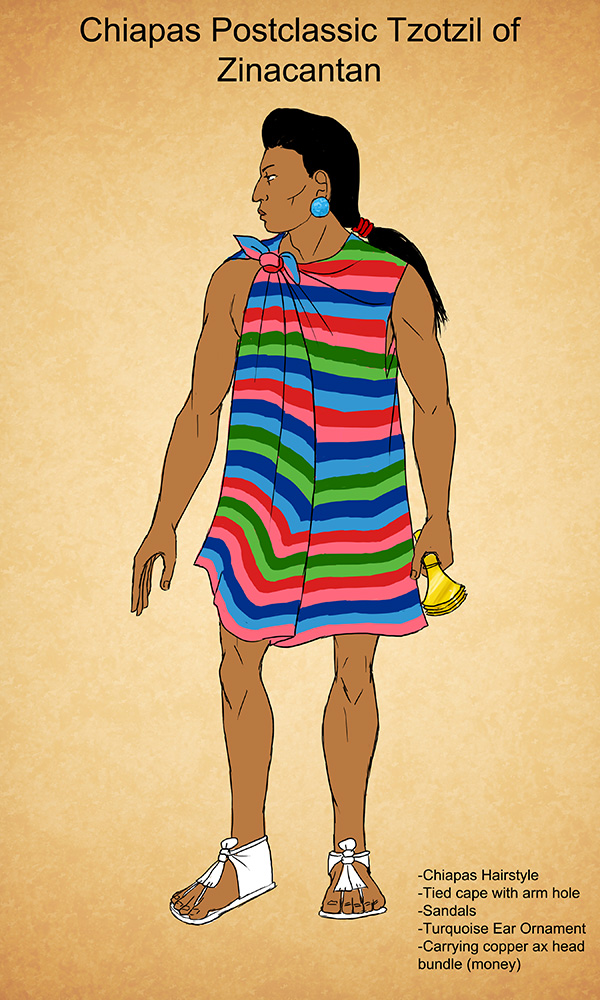ShopDreamUp AI ArtDreamUp
Deviation Actions
Description
A few months ago I did a Chiapas outfit of the Postclassic period. Normally I would just reupload the edited version cryptically, but since the changes were major I decided to resubmit the deviation again. The reasons for the changes are due to some noticeable differences I found when I got my hands on the actual color-copy version of the Florentine Codex. Anyway, about this region Chiapas:
Unfortunately, I won’t be doing female outfits for this region because I don’t have sufficient data for it. The image this is based on only included a male and two Aztec spies dressed as Mayans.
Chiapas is a Mexican state located in the southeast of the country. The state shares a border with Guatemala and it is the site of many famous Classic-period Maya sites like Palenque, Yaxchilan, Bonampak, Tonina etc. Sadly, a lot of information on the Postclassic period is less ‘popular’ and receives less attention from scholars and the mainstream public. That and very few documents that could tell us something have survived - unlike the more detailed documents written for the Aztec and Yucatecan Maya.
During the Postclassic period, Chiapas was as it is now, a very diverse region. The most powerful people at this time were the Chiapaneca from Chiapan, The Tzotzils centered in Tzinacantlan, the Cimatecs of Cimatlan, and the Zoque. The Chiapaneca spoke a language of the Oto-Manguean family. More specifically they belong to the Manguean languages of which only two are known to exist: Chiapanec and Chorotega (from Costa Rica and Nicaragua).The Tzotzils are Maya who speak Tzotzil. Cimatecs are believed by some to be related to the Chontal Maya people of Tabasco. Other Maya groups are the Tzeltal, Ch'ol, Tojolabal, Lacandon and Mam. Other groups include the Zoque, Quilena, and Motozintlecos. Many of these communities still maintain their traditions, but they also face many dangers. And their resistance against these threats are as real as ever from the initial Spanish invasion 500 years ago to the current Mexican Government and the increasing pressure from globalization.
Note: Most of these groups do not include the Soconusco region of Chiapas, which is included in another illustration I made.
Now about this piece. The illustration is based on a drawing from the Florentine Codex. Specifically from Book 9 concerning Aztec merchants. In it, Fray Sahagun describes how Aztec merchants called Pochteca, also served as spies for the Triple Alliance. The Aztec spies dressed like the natives of Tzinacantlan (Now called Zinacantan). The picture accompanying this text shows two Aztec merchants dressed as Tzotzils and a Tzotzil from Tzinacantlan. Here's a picture from the Codex I took if you want to see for yourselves. img120.imagevenue.com/img.php?…
Notice the hair and unusual cape. The hair is described as being like that of the Cimatecs, Otomi and Chontales (I'm assuming Sahagun means the Chontal Mayans and not the Oaxacan Chontales). The capes design made it suitable attire to be worn in combat as it did not obstruct arm movement.
And one last thing to mention. That bundle of copper ax heads he carries was a form of currency during the Postclassic period. It is the closest thing Mesoamerican's had to the 'coin' currency of Eurasia. These copper ax heads varied in sizes. This is one of the larger sizes. And they are almost always used in stacked packs. Their value is unknown, but it was certainly higher than cacao beans' which were the most basic forms of currency. Note: in the codex he carries an actual ax for combat use - as opposed to ax heads used for economic purposes.
Unfortunately, I won’t be doing female outfits for this region because I don’t have sufficient data for it. The image this is based on only included a male and two Aztec spies dressed as Mayans.
Chiapas is a Mexican state located in the southeast of the country. The state shares a border with Guatemala and it is the site of many famous Classic-period Maya sites like Palenque, Yaxchilan, Bonampak, Tonina etc. Sadly, a lot of information on the Postclassic period is less ‘popular’ and receives less attention from scholars and the mainstream public. That and very few documents that could tell us something have survived - unlike the more detailed documents written for the Aztec and Yucatecan Maya.
During the Postclassic period, Chiapas was as it is now, a very diverse region. The most powerful people at this time were the Chiapaneca from Chiapan, The Tzotzils centered in Tzinacantlan, the Cimatecs of Cimatlan, and the Zoque. The Chiapaneca spoke a language of the Oto-Manguean family. More specifically they belong to the Manguean languages of which only two are known to exist: Chiapanec and Chorotega (from Costa Rica and Nicaragua).The Tzotzils are Maya who speak Tzotzil. Cimatecs are believed by some to be related to the Chontal Maya people of Tabasco. Other Maya groups are the Tzeltal, Ch'ol, Tojolabal, Lacandon and Mam. Other groups include the Zoque, Quilena, and Motozintlecos. Many of these communities still maintain their traditions, but they also face many dangers. And their resistance against these threats are as real as ever from the initial Spanish invasion 500 years ago to the current Mexican Government and the increasing pressure from globalization.
Note: Most of these groups do not include the Soconusco region of Chiapas, which is included in another illustration I made.
Now about this piece. The illustration is based on a drawing from the Florentine Codex. Specifically from Book 9 concerning Aztec merchants. In it, Fray Sahagun describes how Aztec merchants called Pochteca, also served as spies for the Triple Alliance. The Aztec spies dressed like the natives of Tzinacantlan (Now called Zinacantan). The picture accompanying this text shows two Aztec merchants dressed as Tzotzils and a Tzotzil from Tzinacantlan. Here's a picture from the Codex I took if you want to see for yourselves. img120.imagevenue.com/img.php?…
Notice the hair and unusual cape. The hair is described as being like that of the Cimatecs, Otomi and Chontales (I'm assuming Sahagun means the Chontal Mayans and not the Oaxacan Chontales). The capes design made it suitable attire to be worn in combat as it did not obstruct arm movement.
And one last thing to mention. That bundle of copper ax heads he carries was a form of currency during the Postclassic period. It is the closest thing Mesoamerican's had to the 'coin' currency of Eurasia. These copper ax heads varied in sizes. This is one of the larger sizes. And they are almost always used in stacked packs. Their value is unknown, but it was certainly higher than cacao beans' which were the most basic forms of currency. Note: in the codex he carries an actual ax for combat use - as opposed to ax heads used for economic purposes.
Image size
600x1000px 267.15 KB
© 2012 - 2024 Kamazotz
Comments8
Join the community to add your comment. Already a deviant? Log In
Beautiful! My relatives are the Chiapanecos, I am Mankeme from Nicaragua (Chorotega). I love this... it tells me more about how my ancestors would have dressed. Your work is very inspiring and it is giving me great ideas. This is what our indigenous people wear today during festivities: photos.end.com.ni/2011/08/639x…... Very Spanish...
These are depictions in polichrome style ceramic left by my ancestors (a lot of female and inter-sexed people depicted like this with hands on hips and in semi-seated or kneeling/crouching position):
arky.ucalgary.ca/mccafferty/si…
I can't for the life of me figure out what the headress is all about... LOL lemme know if you have any ideas...
siramabajo AT gmail


































